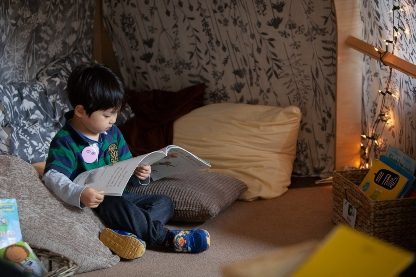An article from Shauna McIntosh about her experience of using a Froebelian approach to co-construct the curriculum with young children at Cameron House Nursery School - an early years setting in Scotland.
Relationships matter
Our whole staff team at Cameron House Nursery School, Edinburgh (led by inspirational Froebelian Headteacher, Chris McCormick) had been deeply engaged in robust professional dialogue, considering:
• how the three distinct parts of our planning process with children (gathering ideas, making plans, reflecting together) had evolved
• how they were inter-related
• how each essential element contributed to the whole planning process .
Shared Froebelian pedagogy was our guide, as we began to collaborate and agree on how best to creatively capture this planning process on paper.
Our ideas emerged and connected until our 'Good Idea Approach' was born!
Unity and connectedness
The Good Idea Approach is based on the Froebelian principle of unity and connectedness.
At each stage in the process of researching and creating our planning approach, we explored the notion that learning is not compartmentalised but linked - as Froebel said, ‘link, always link’.
Autonomous learners
Our approach to planning with young children draws on the Froebelian principles on which our pedagogy is based.
It values, promotes and celebrates children’s voice, enabling children to take ownership of planning for their own learning and, in so doing, to co-construct the curriculum.
At the heart of the approach are the good ideas that children bring with them, that occur to them spontaneously or that develop like a little seed growing over time.
We observe the ideas that children cultivate through their actions, emotions and words. Enabling and empowering children, this approach to planning:
- gives children autonomy in their learning
- builds on what children can do
- values children as active agents
- enables children to learn about learning and think about thinking.
We are all full of good ideas... Sharing ideas connects us.
What does co-constructing a curriculum look like in practice?
On an A4 sheet - divided into three boxes titled The Good Idea, The Plan, What Happened - with the child’s name and date:
- capture the child’s Good Idea on paper in the moment with the child in a few short sentences
- sharing thoughts through conversation, the child and the adult formulate, write (mark-make) The Plan which ensures the Good Idea happens
- display the paper at child height so it’s visible to all the children and serves as a reference point
- once The Plan has been carried out, the child and adult reflect on learning, recording What Happened.
At each stage, invite the child to mark-make. Use the child’s own words as much as possible.

Case study: Elijah’s Good Idea
Elijah and an adult had finished reading “Supertato”. He asked if we had any more “Supertato” books like the ones on the back cover. We checked the book shelves but there were none.
Elijah: I’ve got a idea! We could go to the library.
Adult: That’s a really good idea! Let’s make a plan!
Elijah collected a special piece of paper and we began.
The Good Idea
Elijah says, “We can go to the library to look for more “Supertato” books.”
The Plan
We will organise to go to the library next week.
Elijah says, “It’s quite far away, so we can go on the bus.”
We will look in the library for “Supertato” books.
Everyone will choose a book to borrow for nursery – 24 children, 24 books.
The books will be heavy.
Elijah says, “I know, I can bring my suitcase! We can put the books in and I can just pull it along.”
We will read the books at nursery.
What Happened
“We went on the bus to the library. We looked for “Supertato” books. We found “Supertato: Veggies Assemble!” and “Supertato: Run Veggies Run!” and lots of other books.”
Elijah put all the books in his suitcase and pulled it back to nursery.
We read all the books.

We observe the ideas that children cultivate through their actions, emotions and words.
Knowledgeable, nurturing educators
In adopting this approach, knowledgeable, nurturing educators:
- hold space for children’s ideas
- support children to develop ideas and to realise their plans
- value children’s engagement with the process of planning for their own learning and reflecting on learning
- enable children to share thoughts, ideas and plans with others
- value what and how children want to learn.
We are privileged, in our important and unique role as educators and facilitators:
- to support children to follow their interests through relevant, real-life experiences
- to enable children to make the impossible possible
- to offer the freedom with guidance that children need
- freeing up time for our children to be: to play, to potter, to ponder; to wallow, to watch, to wonder.
We are all full of good ideas. They help us to make the inner, outer. Sharing ideas connects us.
In the words of Earl Nightingale, “Everything begins with an idea.”
About the author
Shauna McIntosh has been an Early Years educator for over 28 years. She has completed the Froebel in Childhood Practice course at University of Edinburgh and is a co-author of a chapter in the award-winning book, Putting Storytelling at the Heart of Early Childhood Practice. She is now an Early Years Teacher with the Edinburgh Pedagogy Team, supporting early years settings across the city.
Shauna created this short article during the Froebel Trust's Writing Workshop held in Summer 2022.
Froebel Trust Research Highlights
This title, all about curriculum making with young children, is part of a free to download series of resources created to support educators in their work with babies and young children.
Each title in the Froebel Trust Research Highlights series summarises the latest in early childhood research - and makes links between research and practice in Froebelian education today.


